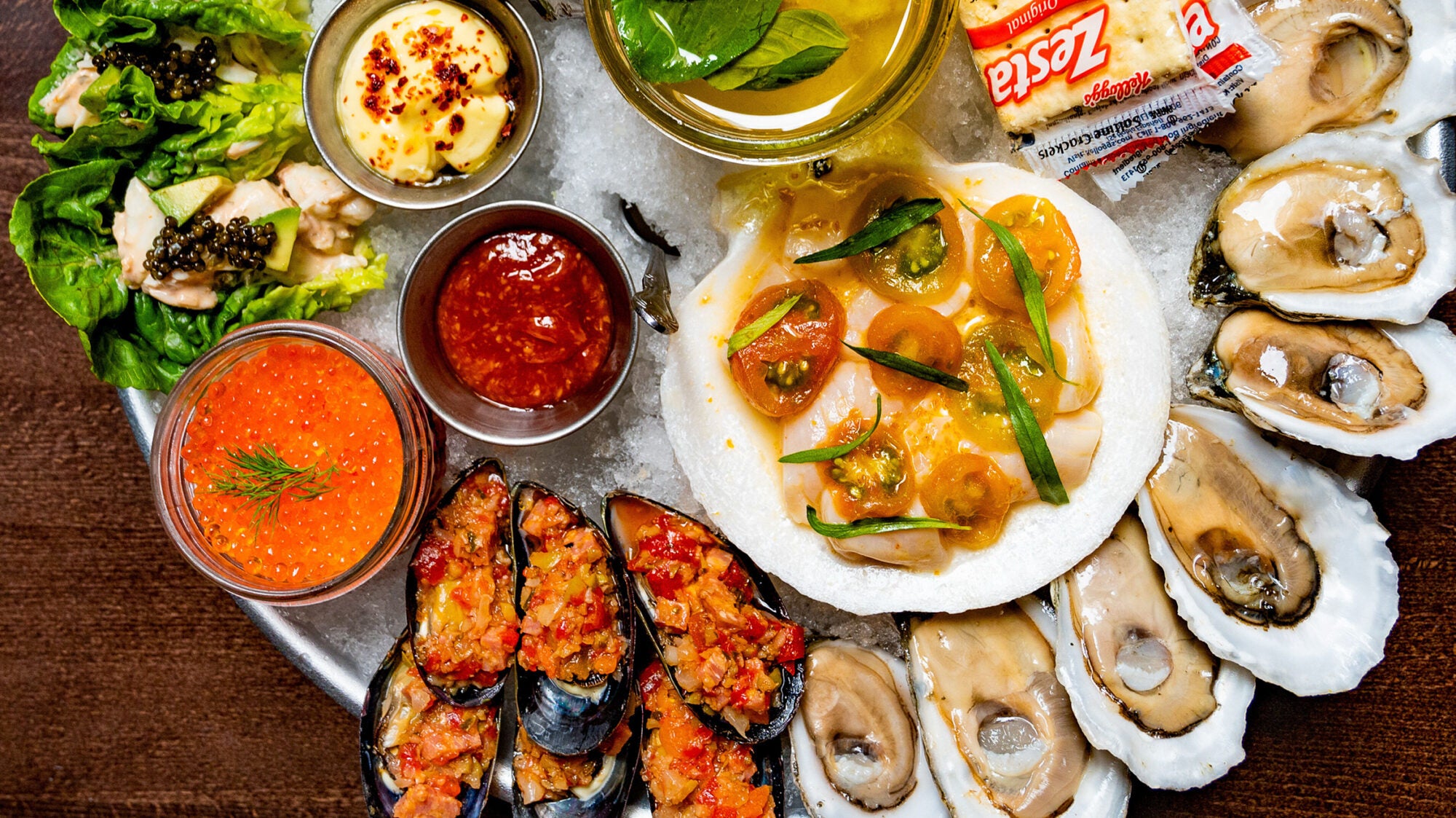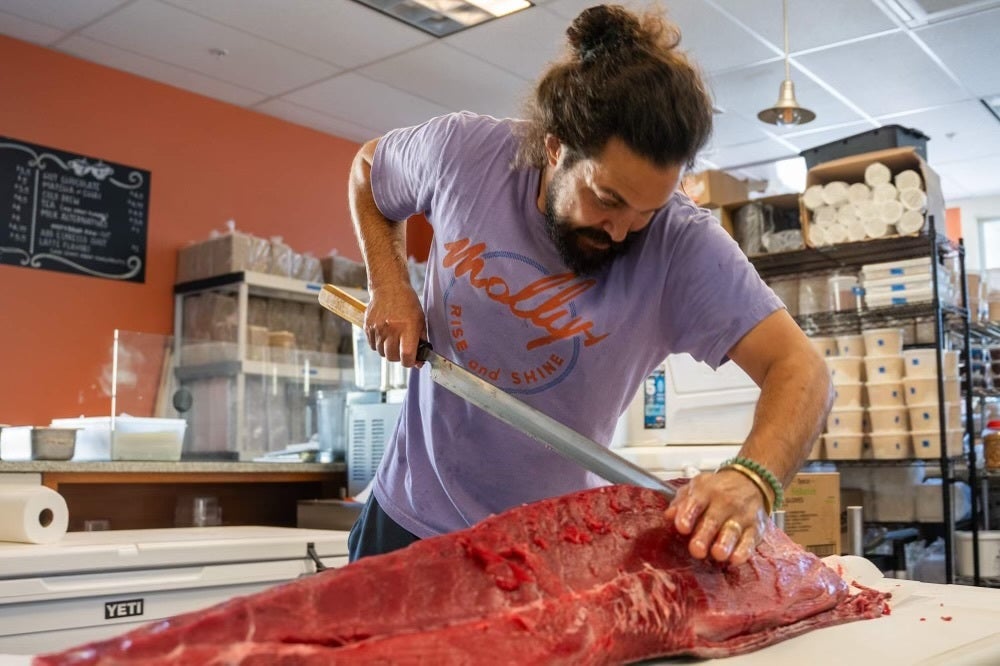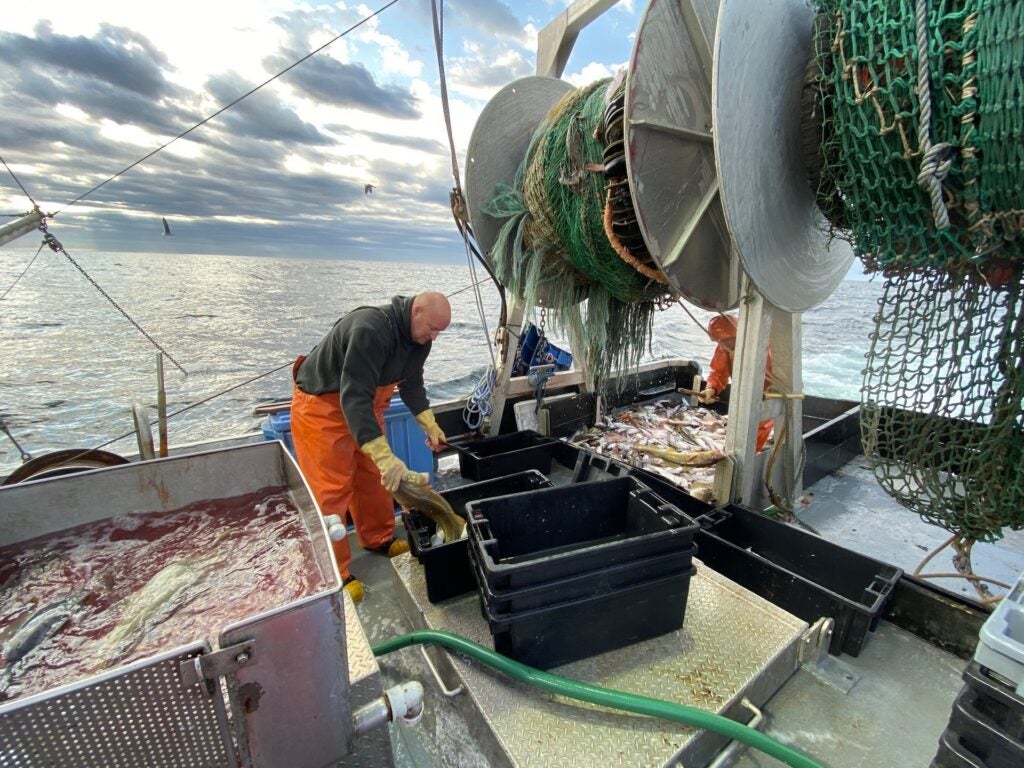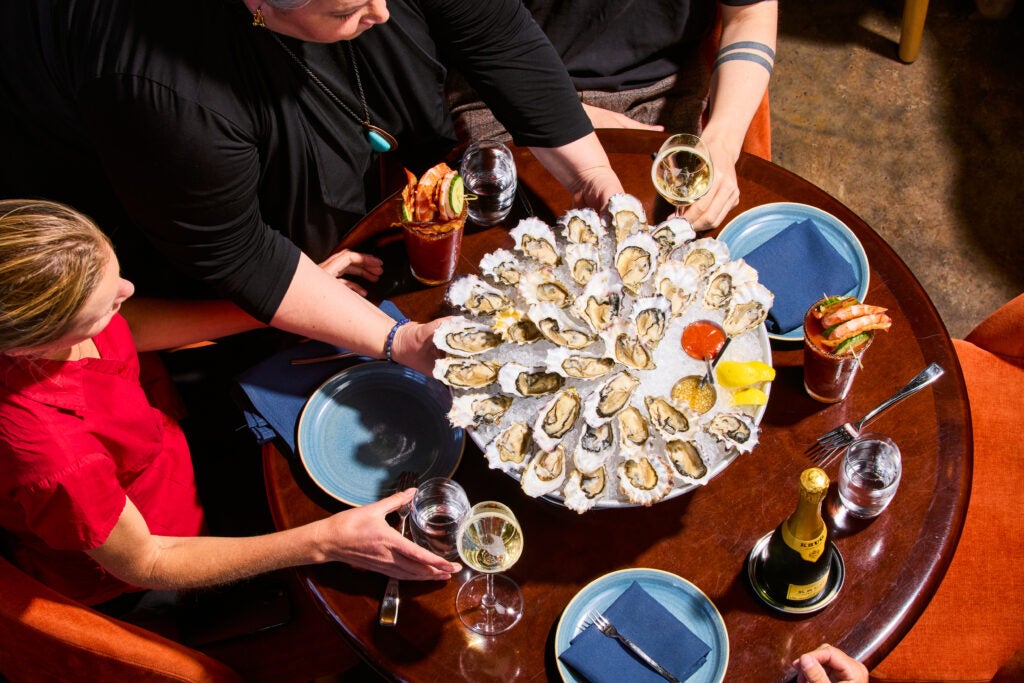
The tuna is fattier, the shellfish are sweeter, and restaurants are all the better for it.
When the temperature drops to bone-chilling lows and the sparrows and tourists scuttle off to warmer pastures, the Gulf of Maine begins to stir with life. Divers wade through cold kelp forests in search of sea urchins for prized uni. Oysters, sweet and firm in the cold season, are harvested for immediate shucking and slurping, finding their way to some of the country’s best restaurants. Scallops, Jonah crab, and mussels are hauled from the depths, ready to impress with their bright, briny flavors. When the calendar turns each season, the state’s restaurants truly come alive, spoiled by the rich diversity of local seafood.
Maine’s postcard-ready coastline has become synonymous with idyllic summers and mayo-slathered lobster rolls. In 2024, nearly eight million tourists arrived between May and August. Few, however, think of Maine for its winter tourism, and fewer seek out its seafood beyond the well-known staples of lobster and oysters. After Labor Day, many restaurants limit their hours or accept the reality of slower business.
But as the summer fades, many fish and shellfish have already migrated north to Maine’s cooler waters to escape the southern heat and fatten up with flavor before heading south again in December. While not all Maine restaurants serve local seafood, the ones that do reap the benefits of uni, scallops, crab, tuna, oysters, mussels, and more. Come late fall, visitors can stroll into some of the state’s best restaurants without needing a reservation, glance at a seafood-forward menu, and feast on local catches at peak tastiness.

Mr. Tuna in Portland.
Feeling like I’ve been let in on a closely guarded secret, I arrange an appointment with Mr. Tuna on a brisk November day. Inside his hand roll shop just off Portland’s main drag, Mr. Tuna waves me over to the minimal 14-seat counter. Wielding a sturdy knife, he slices into a marbled hunk of Atlantic bluefin tuna, wraps it in nori, and places a hand roll in front of me. Inside, there’s slightly firm sushi rice nestled below pickled radish, a shower of scallions, and a floppy shiso leaf. The tuna is a glistening pink, streaked with fat as if touched by a paintbrush, and it’s one of my favorite bites of seafood to date. “Straight from the Maine waters,” he says with a grin.
Mr. Tuna is the moniker for chef Jordan Rubin, who co-owns the eponymous counter, as well as Bar Futo, with his wife, Marisa Lewiecki. In Portland, Rubin has emerged as an advocate for local seafood, given his 20-plus years of experience. It’s a philosophy he takes seriously at both restaurants. At Mr. Tuna, there’s something local for everyone: creamy uni and crab with yuzu mayo, broiled scallops with crackling tempura flakes, and buttery, melt-in-your-mouth tuna hand rolls topped with everything from sweet mango slivers to dollops of zesty yuzu kosho.
But while the best tuna yields occur from September to December and shellfish like scallops and crab are at their most delicately flavored through March, few visitors are there to experience the bounty at its best. Aside from Maine residents, Rubin says only a few chefs and insiders can speak to the region’s phenomenal seafood. “A lot of times, chefs have to come to try it themselves,” he says. “When industry people visit Mr. Tuna, they’re like, ‘Holy Shit. How is this so good?’”
To understand how Maine supports an abundance of seafood, one need only look into the water. Adam Baukus, who leads sustainable seafood programs at the Gulf of Maine Research Institute, is quick to rattle off its geographical advantages. The offshore banks—submerged land masses—create ideal conditions for marine life. Much of the catch is close to the shoreline, too, which means fishermen can likely bring it to chefs the very same day. On top of that, the United States enforces strict quotas on the east coast to prevent exploitative overfishing and habitat degradation. (Given that Atlantic bluefin tuna were once considered overfished, their steady recovery may come as a surprise.) “More than 90% of bluefin along the North Atlantic coast are selectively harvested one at a time using rod and reel or harpoons,” Rubin says.

Aboard a trawling vessel off the coast of Maine.
Most critical to the quality of the seafood are the waters themselves. Cold, murky, and rich with plankton and small fish, the Gulf of Maine attracts hungry fish that fatten up during summer and early fall. The chilly temperatures also inhibit salt from quickly entering shellfish, which allows for sweeter, more flavorful meat. As Baukus tells me proudly, “We’re a destination of sorts in the ocean and tend to hold species longer.”
It’s also impossible to talk about Maine seafood without mentioning climate change and how it has impacted the environment. While the Gulf waters encourage vitality in the winter, shifting water temperatures have disrupted the environment. Seafood that once thrived, such as cod and northern shrimp, have migrated farther north past Maine to even chillier temperatures. That change has also welcomed new species. Black sea bass and squid, traditionally found farther south, can now be spotted in Maine. This is the reality that Maine chefs, fishmongers, and scientists grapple with year-round.
At Rubin’s two restaurants, he goes the extra mile to ensure that customers receive the freshest seafood. Every week during the season, the restaurant hauls in catch averaging about 400 pounds. Some of it is served on the spot. Otherwise, Rubin utilizes the restaurant’s super freezer, which can extend the shelf life of seafood for an additional two to three months. When the bluefin tuna migrate south and the frigid waters make fishing impossible, Rubin sources from the Carolinas, where the same school of fish can be found, until Maine’s fishing season resumes in late summer.
It’s not only the rarefied shellfish, uni, and bluefin tuna that flourish in the cold temperatures. More common varieties of whitefish exist all year in Maine, and they, too, are more plentiful in the winter, according to Baukus. Thirty minutes south of Portland in Biddeford, the fish and chips purveyor Fish & Whistle is committed to working with Maine seafood all season long. On Jason Eckerson and Kate Hamm’s menu, everything is fresh, never frozen, and sourced from whatever the local fishermen happen to catch that week.

Jason Eckerson and Kate Hammte of Fish & Whistle.
Through his shop, Eckerson, who previously sourced seafood for Portland mainstay Eventide Oyster Co., hopes that customers become curious about Maine’s lesser-known fish varieties such as pollack, hake, and cusk, too. “It wasn’t like there was a mission to serve this stuff,” he says. “How do we talk about this stuff without preaching? Because it is just fried fish.”
Outside of the state, chefs are looking to Maine for high-quality seafood, especially during the colder months. In Philadelphia, chef Alex Kemp, who co-owns My Loup with his partner, Amanda Shulman, regularly features regional catch on the menu. Once winter arrives, he exclusively sources mussels from Bangs Island in Portland, Maine, and Maine uni, which he lauds for its clean, briny finish and superior creaminess. Kemp claims Maine uni has no substitute—including the more coveted unis from Santa Barbara and Japan. As a chef who cares deeply about seasonality, Kemp says Maine seafood has never failed to deliver on quality and taste: “If you get a cucumber or tomato out of season, you can always put salt and acid on it. But it’s really hard to hide bad seafood.”
With some of the nation’s top chefs vouching for Maine’s seafood, I wonder why it hasn’t appeared on more menus this season. For starters, not all restaurants list where their seafood comes from, which would help raise the state’s profile. Additionally, if diners aren’t aware of Maine’s offerings, they won’t ask for them. This raises a larger issue: seafood is a global commodity, and sourcing locally is not always straightforward. Budget-conscious restaurants often choose farm-raised seafood for its affordability and consistency, especially during winter. Others may look to foreign products such as those from Japan that carry a certain cachet. As Baukus points out, “It’s often easier to buy fish imported from other countries than it is to buy fish that is caught locally.”

Waterbar in San Francisco.
And yet Maine’s seafood continues to flourish in the cold season. Compared to Japan, Spain, Mexico, and other global seafood markets, Maine operates on a much smaller scale. But the demand is still there and slowly growing. Upstream Portland, a tuna wholesaler that exclusively works with restaurants in Portland, Maine, reported that their Atlantic bluefin tuna supply has tripled in the last three years. Numbers like these represent a win for chefs like Rubin and those at the Gulf of Maine Research Institute. “I want people to know how great our seafood is,” Rubin adds. “I want people to put Maine seafood on their menus.”
In late December, I am seated in the dressed-up dining room at Waterbar, a San Francisco restaurant overlooking the Bay. Across from me sits the restaurant’s purchasing manager, Eric Hyman, bespectacled and bearded, who can’t stop talking about Maine’s rarest oysters. It’s the fun and fanatical part of his job. At Waterbar, Hyman makes all purchasing decisions, which means he sources everything from lobsters to caviar and any other exceptional seafood that catches his eye.
To him, the state has always stood out for its responsibly sourced offerings, different from those of his local waters. “Maine is cold enough in the summers for oysters to thrive, and they’re even better in the winter,” Hyman tells me. “And there are a lot of small fishing communities that we could support.”
Thousands of miles from Maine, I scan Waterbar’s menu and spot the state’s seafood featured in several dishes. Hyman guides me through his favorites: plump and meaty Damariscotta River oysters, cornmeal-crusted fish and chips from the Gulf of Maine, and the crowd-pleasing lobster roll. With the San Francisco–Oakland Bay Bridge in full view and a smattering of plates before me, I picture how far this seafood has come. I close my eyes, inhale the aroma of the oyster, and for a second I’m transported back to the breezy, blisteringly cold shores of Maine.